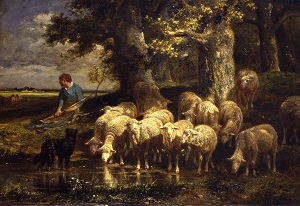Charles-Emile Jacque (French, 1813–1894)
A Shepherdess with her Flock, 1852
Oil on canvas, 18 1/2 x 26 1/2 in.
Signed, dated, and annotated, reverse: J’attatter que ce/tableau est original/ et peint par moi se/ en 1852–fait à Paris/ ch. Jacque
1995.2

In 1851 Jacque began dividing his time between Paris and the village of Barbizon. Although he continued to depict natural and agrarian scenes, Jacque did not always complete his works in Barbizon or the nearby countryside –– we know from the note on the back of this work that it was painted in Paris. The partial move back to the city was partially motivated by Jacque’s burgeoning success, which grew around 1850 thanks to his paintings of pigs and chickens. His representations of sheep, however, did not prove as popular, and in general Jacque only began to actively paint sheep after encountering Constant Troyon’s depictions of cattle in 1853. By 1855 sheep had become one of Jacque’s most popular subjects, and the public, especially Orléanist aristocrats and French industrialists, collected them. This fashion perhaps influenced the American taste for Jacque’s work during the Gilded Age, when connoisseurs such as William Thompson Walters, Theodore Havemeyer, and August Belmont all paid fair sums for his paintings.


